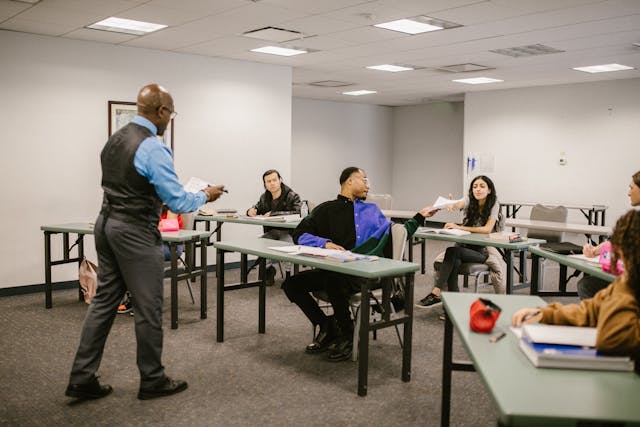The biggest obstacles to MTSS success in schools

While 90% of schools in the United States utilize the Multi-Tiered System of Supports (MTSS), many don’t realize or fully appreciate its benefits. Despite proven efficacy, multiple challenges can prevent schools from realizing the full academic, behavioral, and social-emotional benefits MTSS offers. In theory, tiered interventions can help schools meet the diverse needs of all students. In practice, though, obstacles can get in the way.
Insufficient funding and resources
Unfortunately, budget constraints can negatively impact the success of Multi-Tier Support Systems. At the tier 2 and tier 3 levels of intervention, things like targeted small-group instruction and one-on-one interactions are necessary to offer students vital support, but require training and resources to be effective and support students
When funding is tight, it can be challenging to hire and train the specialized faculty and staff necessary to run programs. Budget constraints can also prevent the purchase of essential intervention materials, reducing the positive impact your Multi-Tier Support framework can offer. When students don’t receive the individualized attention they need, it undermines any MTSS goals you’ve implemented.
What to do: Leverage mental health grants for schools or funding streams to support MTSS more strategically without draining your general education funds. For example, IDEA Part B’s Coordinated Early Intervening Services (CEIS) might be a resource you can use to fund your MTSS efforts.
Lack of staff training and expertise
Without adequate training on MTSS protocols, faculty and staff won’t feel confident in delivering support or using data to make decisions about students’ needs. Their expertise is foundational to the success of tiered intervention plans offered by MTSS. A lack of training will result in uneven or inappropriate implementation.
MTSS efforts need to be consistent. If some educators apply protocols completely, while others use a less systematic, non-evidence-based approach, the overall intervention strategy and outcomes will be weakened and less effective in supporting students.
What to do: Start with buy-in by involving your team from the beginning. MTSS planning and implementation are crucial for maximum impact. Allow stakeholders to share their thoughts and ask questions, and ensure they receive training to understand their role and the philosophy behind the power of the MTSS framework. Training prevents frustration and enhances the likelihood of a positive schoolwide impact.
Data collection and progress monitoring issues
The success of any MTSS program depends on gathering accurate and timely student data. Information should be gathered through universal screening, progress monitoring, and regular assessments. If data isn’t collected or progress isn’t monitored, it becomes more difficult to identify student needs and determine when supports should be adjusted. Without the data, tailoring interventions effectively is nearly impossible.
There are some common data collection challenges you might run into, including:
- Outdated assessment tools
- Inconsistent or incomplete data
- Lack of staff or time to thoroughly analyze
- Overwhelmed staff
- Unclear roles
- Communication gaps between teams
What to do: Create checklists and protocols and have clear roles to manage information collection, assessments, and data entry. Use systems that are reliable and effective, and allocate enough time for analysis.
Inconsistent implementation across tiers
It’s critical for tier 1 (universal), tier 2 (targeted), and tier 3 (intensive) support to be uniform. Some tiers might get more attention than others, but inconsistency increases the chance of students falling through the cracks. Students who need the most intensive interventions rely on support that’s stable. If tier 1 supports are strong but tier 2 interventions are poorly executed, students may not receive the help they need, causing challenges to escalate quickly.
What to do: Ensure every level of educational support you offer is delivered with consistent effort and that adequate time, training, and assessments are enforced. Document MTSS plans and regularly review successes and weaknesses at all tier levels so you can make course corrections quickly if needed.
Resistance to change and school culture challenges
Resistance to change and general skepticism are two of the biggest threats to a successful MTSS adoption. For it to work, MTSS needs a complete shift in mindset and a willingness to collaborate. Establishing and communicating clear processes can prevent resistance from becoming a roadblock.
Cultivate a positive culture that views MTSS as essential to student success. This begins with strong leadership buy-in, transparency, effective communication, and sharing of data outcomes—all of which can help shift attitudes.
What to do: To achieve success, schools must overcome resistance. This can be done by forming MTSS teams and clearly defining expectations. Don’t forget to celebrate the small wins as students find success.
Limited family and community engagement
Family involvement is critical to student learning, academic success, and emotional well-being. Challenges often stem from language barriers and inconsistent communication within instruction. Another issue is that families are not aware of the MTSS supports available, which ultimately limits opportunities for student growth and success. This also prevents families from reinforcing interventions at home—an important factor in building trust.
Positive family engagement can lead to improved academic outcomes while reducing behavioral issues, which is especially important at the tier 2 and tier 3 levels.
What to do: Make intentional efforts to engage families by meeting them where they are. Host gatherings in safe, comfortable community spaces. Connect them with supportive, non-judgmental resources, and use culturally responsive communication with materials offered in multiple languages.
“Family involvement helps to provide consistent support to reach emotional and educational goals. This support assists in wellbeing and raises emotional and behavioral health.”
- Laura Magnuson, MA, MS, LAMFT, VP of Clinical Engagement
Strategies for overcoming MTSS challenges
Challenges can disrupt the flow and success of your MTSS framework; however, implementing specific MTSS best practices can help ensure your efforts pay off.
- Prioritize training and coaching: Staff training and coaching should continue beyond initial workshops. Follow-up support ensures faculty and staff have the skills, resources, and support they need to implement MTSS strategies with confidence.
- Invest in data systems: Robust data collection systems can streamline collection, analysis, and monitoring. They can also identify at-risk students and flag potential issues early, allowing you to address them promptly. There should be clear protocols in place and consistent fidelity checks to ensure data collection and analysis runs smoothly, to ensure students are getting the support they need.
- Get leadership support: Build leadership buy-in by promoting educational and health outcomes and incorporating diverse staff voices into MTSS planning.
- Foster a collaborative school culture: Dedicate MTSS teams and use consistent communication practices to align expectations and offer a sense of ownership.
- Engage families: Actively engage school families by using culturally responsive practices, providing multi-language communication, and connecting families to informative community services.
Enhancing MTSS outcomes through accessible mental healthcare
Working through the MTSS challenges is well worth every effort it takes. Accessible mental healthcare in education can play a crucial role in boosting the effectiveness of your program.
Providing students with accessible, affordable counseling and therapy services is easy with digital partners like Talkspace. Online therapy platforms reduce barriers to care by offering tailored mental health resources you can seamlessly integrate into your MTSS framework. Talkspace provides social-emotional support that fosters well-being at every level. When mental healthcare is accessible without stigma, students are more likely to use the services and can thrive, academically and emotionally.
Discover how Talkspace can enhance your MTSS efforts in schools by requesting a demo today. With effective interventions, every student can have access to the support they need to succeed.
Sources:
- I-MTSS Research Network. 2024. “What Is the Current State of I-MTSS Implementation?” Report. University of Connecticut. https://mtss.org/wp-content/uploads/2024/02/States-of-I-MTSS-Brief-2024.pdf. Accessed November 6, 2025.
- Nitz, Jannik, Fabienne Brack, Sophia Hertel, Johanna Krull, Helen Stephan, Thomas Hennemann, and Charlotte Hanisch. 2023. “Multi-tiered Systems of Support With Focus on Behavioral Modification in Elementary Schools: A Systematic Review.” Heliyon 9 (6): e17506. https://doi.org/10.1016/j.heliyon.2023.e17506. Accessed November 6, 2025.
- “Coordinated Early Intervening Services (CEIS) Fiscal and Student Data Tracker.” n.d. Idea Data Center. https://ideadata.org/resources/resource/1689/coordinated-early-intervening-services-ceis-fiscal-and-student-data-tracker. Accessed November 6, 2025.
- The Annie E. Casey Foundation. 2025. “The Role of Parental Involvement in Your Child’s Education.” August 10, 2025. Below, you can explore the most common MTSS challenges schools face and learn how to overcome them so you can get the most out of your MTSS interventions and best meet your students’ needs. . Accessed November 6, 2025.






